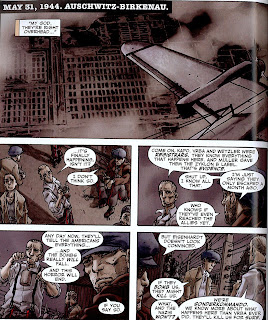Writer: Greg Pak
Artist: Carmine Di Giandomenico
Colours: Matt Hollingsworth
Letterers: Artmonkeys' Dave Lanphear and Natalie Lanphear
Publisher: Marvel
What's it about?
The life of a Jewish boy and his family, living in Germany from 1934 (or thereabouts) to 1948. At the start of the story young Max Eisenhardt is at school experiencing discrimination from his teachers, and at the end he has survived Auschwitz.
It's about the lies that the Nazis put forward, the degradation of the Jews and the Roma and the ways in which the persecuted groups within Nazi Germany survived, or didn't. It is very much focused on the experiences of the victims, not the authorities. It's about the methods and ways in which the Jews were sidelined and pushed out of society, resulting in their murder by millions in the camps.
In terms of Marvel Universe history, Max Eisenhardt is Magneto, enemy of the X-Men. However, and this is important, this is emphatically not a superhero book. There are no superpowers, no supervillains and while metal is used as a theme throughout the book, Max has no ability to manipulate it. This book is Marvel's way of educating a new audience about the Holocaust and the horrors suffered within it.
When discussing a scene in the book concerning a revolt by Auschwitz prisoners, the endnotes on the text state that 'We felt it was important not to depict him (Max) as the actual leader of the revolt. Real human beings led this revolt. We did not want to detract from their almost unthinkable heroism by suggesting that the revolt was only possible because a superhero took charge'.
This should give you some reassurance about the way the subject is handled.
What's good about it?
It's powerful. Three days after reading it I'm still feeling drained.
The authors have carried out a lot of research before putting the book together. Every detail and happening throughout the story, including the town signs and the layout of the camp, is entirely plausible and historically accurate. For example, the surname chosen for Max, Eisenhardt, was picked because the historical adviser said the first choice of name, (Eisenhauer) is a German name, whereas, Eisenhardt, is a German Jewish name. Even Max's jobs and movements around the camp are planned out according the the actual layout of Auschwitz.
The subject matter is sensitively dealt with. The authors decided not to show Max's number tattoo, as to give a fictional character the same number as a real life victim would be beyond crass.
The book refutes the myth that the victims of the Nazis never fought back. It demonstrates how the medical and racial theories propagated by the Nazis were applied to everyday life.
There is a lot of extra material at the back of the book, including:
Endnotes explaining how and why certain approaches were taken
A Teachers guide to working with the book (suitable for English/Language Arts, History, Art and Music subjects)
The story of Dina Babbitt. Babbitt is a survivor of Auschwitz. She was forced to paint portraits of the victims of Mengele's experiments so that Mengele could further develop his race hate theories. A Polish museum now has the paintings and, at the time of publication of this book, has refused to return them to Babbitt.
Backing up all this is a further reading list of books and websites.
What's bad about it?
In Marvel Universe continuity, Magneto is Jewish and his first love is Roma. As hinted at in the recent X-Men movies, Magneto was established as a Holocaust survivor by a writer named Chris Claremont. As such, the book focuses on the treatment of the Jews and Roma. It does not really consider the fate of other groups murdered or sterilised by the Nazis. For example, there is little to no mention of the Ddeaf an disabled, homosexuals, antisocials or political opponents.
This is only a problem in an environment where these other groups are largely ignored in discussions of Nazi Germany and World War II. The lack of visibility of these other victims is an erasure of sorts, so the inclusion of information about them could have made this book better. Having said that, when considered as a story about the Jewish and Romany people only, it is exceptional.
If you wish to learn more about what National Socialism did to other groups may I recommend that you start with Deaf People in Hitler's Europe. This is available from Forest Books, or if you are in America you may wish to purchase it direct from Gallaudet University Press.
What's the art like?
Appropriate. Sometimes full page panels are used, sometimes there are many panels to a page, sometimes the panels are blacked out.
Other Information
Price: 0785126406
ISBN: £14.99






No comments:
Post a Comment